
Backstrap Weaver
© Marilyn Anderson. Linocut, 10″ x 12 3/4″
Maya women are masters at backstrap weaving. This woman from San Antonio Aguascalientes, a famous weaving center, uses a simple ancient loom, made of threads and sticks, to produce a traditional textile. Such weaving is remarkable for its high technical and artistic level. The colors and designs can signify the wearer’s identity and place of origin, as well as having symbolic and religious meaning. Guatemala is the only country in Central America where a strong tradition of backstrap weaving exists and thousands of women continue to practice their art.

Basket Weaver
© Marilyn Anderson. Woodcut, 8″ x 10″
The basket maker uses a very straight forward twining technique with a wild forest rattan vine as the main material. In its long history and continued importance, basket making figures as a Maya traditional art. Its makers in Guatemala utilize a number of different natural raw materials and techniques. Basket making has never been mechanized and so probably never will be industrialized!

Bobbin Winder
© Marilyn Anderson. Woodcut, 9 1/16″x 11 7/8″
Bobbins (spools wound with thread) are needed for warping floor looms as well as for the weaving itself. Young boys in family weaving workshops often do the work of winding bobbins from skeins. (In an industrial setting, this work can be done with machines.) This seemingly simple task still requires precise skills. Skeins must be carefully unwound and placed correctly on the revolving swifts. If carelessly done, the threads become tangled and ruined, making them impossible to be wound onto the bobbins.
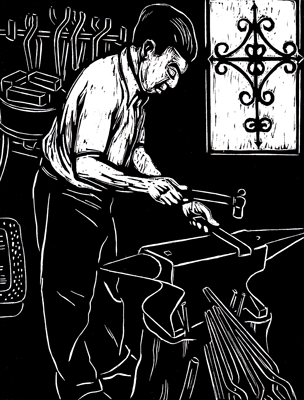
Blacksmith
© Marilyn Anderson. Woodcut, 9 1/16″ x 11 7/8″
In Antigua Guatemala, this blacksmith forges ornamental crosses, chandeliers, hinges, and other pieces in the style of Colonial times. Examples of such forged iron are seen throughout Antigua in public buildings, churches and homes. As both artists and skilled artisans, blacksmiths are capable of producing intricate and creative pieces that can not be duplicated in a factory.

Bracelet (Wrist Band) Maker
© Marilyn Anderson. Woodcut, 9 1/16″ x 11 7/8″
In the 1980s in Guatemala, as well as in Chiapas, Mexico, one saw street vendors offering bracelets (pulseras ) for sale–– for very small sums. Soon, pulseras began to be exported, also with very little return to the young girls who made them. Still today, particularly in tourist areas, similar items are offered. These non-traditional cotton knotted (macramé ) bracelets ( likely introduced by a Peace Corps member ) seem to be the only craft item made in Guatemala that has been done by many school children in the US.

Broom Maker
© Marilyn Anderson. Woodcut, 9 1/16″ x 11 7/8″
This young man from San Luis Jilotepéque pictured in the print expertly made a brooms attractively braided at the top. Near his home, in the “tierra caliente” warm lowland area of Guatemala, palm trees provide fronds, his raw material. Increasingly, however, one now sees bright colored plastic brooms for sale. Although cheerful, when worn out they often are burned with other trash in town dumps emitting foul toxic fumes.

Candle Maker
© Marilyn Anderson. Linocut, 8″ x 10″
A candle maker in Jacaltenango turns a wheel and pours wax over the wicks as she revolves it. Candles can also be made using a mould and some, especially in Antigua Guatemala, are elaborately shaped and decorated. Artisan candle makers in Guatemala generally use bees wax and paraffin as their raw material but the arrayan tree in the tropical areas supplies a natural candle wax while encouraging preservation of forests. The use of candles for cultural, religious and practical purposes continues to have importance.

Carpenter/Cabinet Maker
© Marilyn Anderson. Woodcut, 8″ x 10″
Maya carpenters and cabinetmakers are often generalists whose skills often allow them to make doors and traditional furniture as well as carved artistic decorative figures. Large numbers of Maya men can do some carpentry or make furniture and several towns such as Totonicapán and Nahualá have special renown for their furniture making and wood carving. Maya and non-Maya (Ladino) artisans work in centers such as Antigua and often make elaborate colonial style pieces of many kinds.

Easel Painter
© Marilyn Anderson. Woodcut, 9 1/16″x 11 7/8″
Most Maya traditional artists have, until fairly recently, depicted mainly small sized scenes of traditional culture, work and religious ceremonies. Today, the size of paintings has also increased and some artists use more non-traditional approaches which may include working in very individualistic styles contrasting to the more homogeneous look of canvases done in the past. It is fair to say that a “flowering” of talented artists has taken place, including a number of women painters. Towns such as Comalapa and Santiago Atitlán have produced many fine artists. Guatemala has also produced remarkable non-Maya schooled painters, including the world renowned Carlos Mérida. But the authentic “village” painter’s work has a special place in the hearts of many.
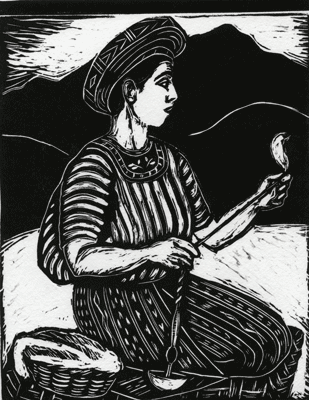
Cotton Spinner
© Marilyn Anderson. Linocut, 8″ x 10″
The spinner of Santiago Atitlán uses a simple ancient apparatus, the drop spindle, to prepare thread intended for backstrap weaving. (The spindle consists of just a slender wooden stick tapered to a point with a round weight about two inches from the base. ) Today, hand spinning of cotton is done much less than in the past. But Maya women from several areas of Guatemala keep alive this ancient art even though they can buy factory spun yarn.
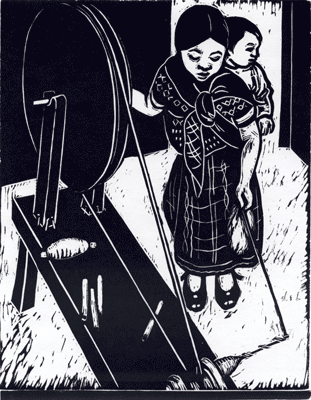
Wool Spinner
© Marilyn Anderson. Linocut, 8″ x 10″
Using a the “Great European Wheel” (see Bobbin Winder) a young girl in Momostenango, spins wool to be woven into blankets. She not only spins but attends school and cares for her brother while working and thus plays an important role in her family’s weaving workshop where the whole family participates in the various processes required for blanket weaving.

Cotton Dyer
© Marilyn Anderson. Linocut, 8″ x 10″
The dyer works in a small shop in Salcajá and uses chemical agents to dye cotton yarns. In fact, the brilliant colors of chemical dyes have long been the “trademark” of the textiles produced by most Maya weavers. However, new interest has arisen in natural dyeing and a number of projects exist that now encourage it. More recently, large dye houses in Salcajá with modern machinery have replaced a number of small workshops.

Floor Loom Warper
© Marilyn Anderson. Woodcut, 9 1/16″ x 11 7/8″
The warper is preparing cotton threads to be transferred to the back beam of a floor loom to be woven into a table cloth. Warp yarns wound off spools on a creel are taken to a revolving frame reel . Both men and women perform this process which demands extreme care because as much as 200 feet of yarn may be wound off the creel’s spools. Warping the loom is one of the necessary steps for weaving, which in the simplest terms, is interlacing warp yarns with weft.

Floor Loom Weaver
© Marilyn Anderson. Linocut, 10″ x 12 3/4″
Maya men, and increasingly, women, in many different towns use the floor treadle loom whose origin dates from after the 1524 Spanish invasion of Guatemala. These weavers produce many kinds of cloth including large quantities of corte, the traditional ikat (jaspé ) wrap–around skirt worn by women throughout Guatemala. Looms of different sizes and types are used –– from simple four harness, to multiharness draw looms and even Jacquard looms.
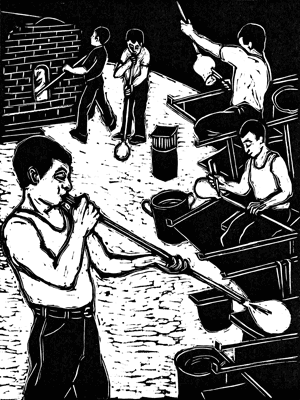
Glass Blowers
© Marilyn Anderson. Linocut, 9 1/16″ x 11 7/8″
The glass blowers alternately blow into a tube to form the molten glass and use tongs and other tools to further shape it. Unlike some other parts of the world, such as Egypt, where glass making was first done thousands of years ago, it was not one of the arts and industries of the ancient Maya. It appears that this craft came to Guatemala relatively recently possibly introduced by the Spanish during colonial times. Glass blowing is not widely done in Guatemala, but one coop in Zunil is noteworthy. Well organized, they produce a variety of items for sale in Guatemala and for export.
The glass blowers alternately blow into a tube to form the molten glass and use tongs and other tools to further shape it. Unlike some other parts of the world, such as Egypt, where glass making was first done thousands of years ago, it was not one of the arts and industries of the ancient Maya. It appears that this craft came to Guatemala relatively recently possibly introduced by the Spanish during colonial times. Glass blowing is not widely done in Guatemala, but one coop in Zunil is noteworthy. Well organized, they produce a variety of items for sale in Guatemala and for export.

Gourd Carver
© Marilyn Anderson. Woodcut, 8″ x 10″
Incising with a knife, the artisan from Rabinal makes charming designs on a blackened gourd to make a “piggy” bank. But the primary use of gourds is practical and for thousands of years the Maya have utilized them. They grow on both trees and vines in a number of areas of Guatemala and can be found in many markets. Today, gourds continue to have a place in the lives of the Maya and retain cultural significance though plastic containers have displaced them for many uses.

Grinding Stone Maker
© Marilyn Anderson
The carver from San Luis Jilotepeque is finishing the rounded oblong part (mano) used in conjunction with the stone metate to grind corn for the dough (masa) to make tortillas, tamales and corn drinks. In many Guatemalan towns and villages, mechanized corn grinders have replaced (metates) but many families still keep one in their homes to further grind the masa processed in the electric machine. All over the world, for thousands of years, people have used a variety of grinding stones.

Hammock Maker
© Marilyn Anderson. Woodcut, 9 1/16″ x 11 7/8″
In the warm Petén region, a Q’eqchi’ woman constructs a hammock employing a looping technique. A wooden frame supports the hammock in progress and the nylon twine she uses. Traditionally, hammocks are made with more ecological maguey or cotton twine. Hammocks originated among the ancient Maya and people of the Caribbean and were subsequently introduced to Europe by Columbus and widely adopted in many places.

Hat Maker
© Marilyn Anderson. Woodcut, 9 1/16″ x 11 7/8″
In Guatemala, palm hats are still sewn by hand or machine. If you buy one, you can be sure an artisan has produced it. While such hats provide vital protection from the sun and rain, they also have the advantage of being made with locally grown palm fronds. ( See Palm Braider ) However, for many years, artisanal hat making has been affected by the introduction the now ubiquitous factory produced “baseball style” caps. Such headwear is now seen everywhere along with plastic-brimmed hats which also replace handmade items.

Hand Potter
Hand Potter © Marilyn Anderson. Linocut, 9 1/16″ x 11 7/8″
This potter of San Luis Jilotepeque is one of others in many parts of Guatemala who still build, entirely by hand, charming items for cooking, storing water, etc. But nowadays, pottery containers, such as she makes, are much less used –– a trend that began in the 70s with the introduction of plastic water jars and other plastic ware.

Ikat (Jaspé) Knotter
© Marilyn Anderson. Woodcut, 9 1/16″ x 11 7/8″
An ikat worker from Santiago Atitlán ties a series of knots on skeins of yarns to produce both simple and intricate designs. This painstaking work is done by both men and women–– especially in Salcajá but in other places as well. After the knotting of the skeins is completed, they are dipped in dyes, the knots are removed and the yarns are used as the warp or weft in floor loom or backstrap weaving.

Leather Artisan
© Marilyn Anderson. Woodcut, 8″ x 10″
In Guatemala, leather has a many uses from suitcases to simple straps “mecapals” as shown on the wall behind the artisan. (They are placed over the forehead attached to ropes to carry loads on the back.) The suitcase with attractive embossed designs, which in the print is shown being finished, has a nineteenth century feel. Similar ones can still be found in a few Guatemala markets but not as often as in the past for plastic or nylon suitcases now replace them. A leather craftsmen might make other items including sandals, or pack saddles for horses. Shoe making or saddlery require other sets of skills.


Maguey Net Maker
© Marilyn Anderson. Woodcut, 9 1/16″ x 11 7/8″
A net maker from San Pablo La Laguna uses a “figure-eight” construction technique which produces an expandable net that can accommodate various sizes of loads. Although it sounds unlikely, fragile pottery may be carried to market in a net. Nets have been used throughout the world from the time of hunters and gatherers. In Guatemala today, one often sees nets made of plastic twine and rope. But those made in the traditional way from the fibers of the maguey plant offer many advantages as a locally produced, sustainable and ecological product. In addition to its biodegradable fibers, the maguey plant helps to prevent erosion and can even be used for natural medicine.

Maguey Twine Spinner
© Marilyn Anderson. Woodcut, 9 1/16″ x 11 7/8″
Spinning twine from maguey fibers requires deft hand motions to twist two small bunches of fibers together. Even young boys, from a number of towns including Todos Santos, know how to spin twine and extract the fibers they use from maguey plant leaves. With such twine, shoulder bags are made using an ancient technique that results in no knots. These processes, although simple, still can seem magical when seen done.

Mask Carver
© Marilyn Anderson. Woodcut, 9 1/16″ x 11 7/8″
Masks have a long history among the Guatemalan Maya and still play an important role in their religious and cultural expressions. Watching performances of traditional dancers wearing masks, it is easy to imagine the wearers taking on new identities and entering the world of their ancestors. Dancers depict mythological figures and historical characters in many different traditional plays and dances, wearing masks of animals such as deer, monkeys, and jaguars as well as red-faced Spanish conquistadors. Many masks are also now produced for tourists.

Mat Weaver
© Marilyn Anderson. Woodcut, 9 1/16″x 11 7/8″
A man from the town of San Antonio Palopó on Lake Atitlán uses a twill weave to make a mat using tule (reeds) that grow along its shores. Other kinds of plant material are also used for mat production, especially strips from the palm leaf and a type of strong grass. For thousands of years, mats have had wide use in the home and for wrapping bundles and they also have had ceremonial meaning. The ancient Maya created a glyph representing the word for mat and gave the name Pop (mat) to the first month of their calendar.

Embroiderer
© Marilyn Anderson. Woodcut, 8″ x 10″
In some Maya towns, such as Joyabaj, embroidery with a needle and thread is used to decorate traditional textiles. This happens in a number of other places, such as San Mateo Ixtatán, Santiago Atitlán and Sumpango. Especially hand embroiderers of Santiago Atitlán produce many attractive pieces for sale to tourists. Throughout Guatemala, numerous different patterns and motifs may be used. With the introduction of machine embroidery, less of the hand made work is done and men often do it . One result of machine embroidery is that the amount and complexity of decorated surfaces on textiles has increased but not necessarily the charm of the work.
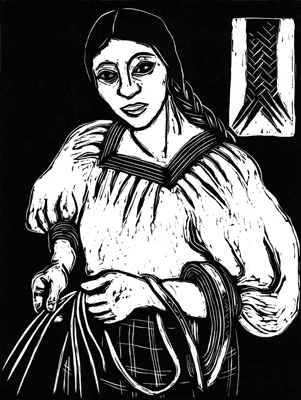
Palm Braider
© Marilyn Anderson. Linocut, 9 1/16″ x 11 7/8″
Around the town of Santa Cruz del Quiché, women can be seen braiding palm strands in many places and at all times –– even while walking. Such work is done by men and women in other towns as well. The fronds of several varieties of palm tree furnish the raw material for the long rolls of braids they produce. Although palm braiding is a simple activity, hat making could not take place without it! Strips from palm leaves are also used for making other items, such as mats (petates).
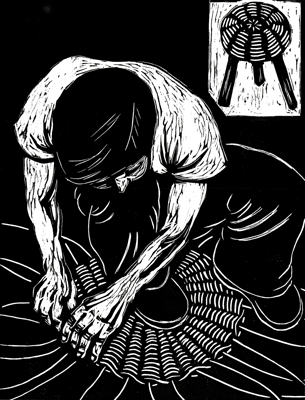
Rattan Furniture Maker
Rattan Furniture Maker © Marilyn Anderson. Woodcut, 9 1/16″ x 11 7/8″
The worker weaves rattan, a climbing cane plant found in the tropical forests of Asia, Africa and the Americas. Using an over and under technique, he weaves a seat for a stool. Employed in a workshop, he also produces tables and elaborate chairs. Almost all of the many species of rattan grow wild. To flourish, they need forest cover and so in many places are adversely affected by over-logging of trees as well as by over-harvesting of the rattan itself.
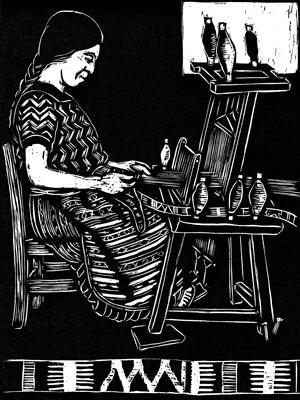
Ribbon Weaver
© Marilyn Anderson. Woodcut, 9 1/16″ x 11 7/8″
To produce ribbons, this weaver in Totonicapán uses a very simple treadle floor loom that has neither cloth or warp beams. This means that one end of the warp threads are attached to a peg in the ground and are gradually unwound as weaving progresses. The other end of the warps are attached at the weaver’s end, supported by a backstrap around her waist. The woven ribbon is wound up from time to time. Several kinds of cotton and wool or yarns are used –– less often, rayon or silk. This weaver produces simple, patterned ribbons that are often exported. More attractive and complex designs are also done and worn as hair adornment by Maya women which may be made in various places.

Sandal Maker
© Marilyn Anderson. Woodcut, 9 1/16″ x 11 7/8″
The maker comes from San Juan Atitán, a very traditional town. But even there the sandals that he makes are now less worn than in the past. For their fabrication he uses leather, a few simple tools and nails for the soles –– but no sewing at all. This style of sandal is noteworthy because it recalls those the ancient Maya are seen wearing on wall paintings, pottery and sculpture.

Shoe Maker
© Marilyn Anderson. Woodcut, 9 1/16″ x 11 7/8″
Makers of traditional shoes, mainly worn in the countryside, are fewer now than even in the recent past, yet still can be found. The shoe seen here have a practicality that make it suitable for the environment of Guatemala: it is a closed shoe that protects the foot but has an open toe, giving an airiness that makes it comfortable to wear without socks. In larger towns, such as Antigua, workshops exist where fine hand shoe and boot making making is done on order for the well to-do.

Shoulder Bag (Morral) Maker
© Marilyn Anderson. Woodcut, 9 1/16″ x 11 7/8″
In Guatemala, there is an astonishing number of different styles, materials, and sizes of shoulder bags. Designs can be simple or complex geometric patterns or they may depict animals and birds. Construction techniques include looping, netting, weaving. knitting or crochet –– as seen here. Men make most shoulder bags, whether of cotton, maguey or wool. Carrying a traditional shoulder bag in Guatemala makes a political statement, as many men and women now use nylon backpacks.

Tin Smith
© Marilyn Anderson. Woodcut, 9 1/16″x 11 7/8″
Having nearly finished a coffee pot, a tinsmith adjusts the final piece for the bottom by cutting off a little of the metal. He works with care and skill to make the pieces fit perfectly before soldering them together. Tinsmithing is a craft probably introduced in colonial Guatemala or even later. The Maya, of course, had no capacity to produce its basic material. Tinsmiths still ply their trade in 21st century Guatemala, even if their wares are used less than in the past.

Backstrap Loom Warper
© Marilyn Anderson. Woodcut, 8″ x 10″
A Maya woman precisely winds the threads off a “swift” (skein winder) onto the warping frame. These weft yarns are destined for making two inch wide ribbons on her backstrap loom.
The cross shaped warping frame she uses is so simple that it can be constructed with few tools by the weaver herself. However, most Maya backstrap weavers use carpenter-made larger size horizontal warping frames with pegs to allow for many more yarns to be wound. This supplies enough yarn so that a wider textile can be woven.

Wheel Potter
© Marilyn Anderson. Woodcut, 9 1/16″ x 11 7/8″
The Spanish introduced the potter’s wheel after their arrival in the Americas and, indeed, some of the pottery done in Guatemala still shows the influence of Spain in its shapes, patterns and glazes. Making pottery using the wheel is, of course, faster than hand building. Wheel potters use glazes (generally hand potters do not) and large kilns to produce many more vessels than can the artisan who uses an open fire and a pit production method. Certain towns in Guatemala, such as Totonicapán and Antigua, have long been known for their wheel made ceramic production. The ancient Maya made remarkable pottery without use of a pottery wheel and decorated them with glyphs and and other motifs, all of which which offer much information about their religious beliefs, ceremonies and daily life.





































